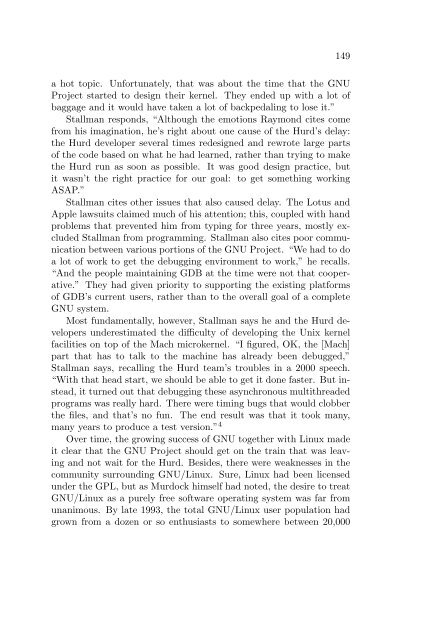You also want an ePaper? Increase the reach of your titles
YUMPU automatically turns print PDFs into web optimized ePapers that Google loves.
149<br />
a hot topic. Unfortunately, that was about the time that the GNU<br />
Project started to design their kernel. They ended up with a lot of<br />
baggage and it would have taken a lot of backpedaling to lose it.”<br />
Stallman responds, “Although the emotions Raymond cites come<br />
from his imagination, he’s right about one cause of the Hurd’s delay:<br />
the Hurd developer several times redesigned and rewrote large parts<br />
of the code based on what he had learned, rather than trying to make<br />
the Hurd run as soon as possible. It was good design practice, but<br />
it wasn’t the right practice for our goal: to get something working<br />
ASAP.”<br />
Stallman cites other issues that also caused delay. The Lotus and<br />
Apple lawsuits claimed much of his attention; this, coupled with hand<br />
problems that prevented him from typing for three years, mostly excluded<br />
Stallman from programming. Stallman also cites poor communication<br />
between various portions of the GNU Project. “We had to do<br />
a lot of work to get the debugging environment to work,” he recalls.<br />
“And the people maintaining GDB at the time were not that cooperative.”<br />
They had given priority to supporting the existing platforms<br />
of GDB’s current users, rather than to the overall goal of a complete<br />
GNU system.<br />
Most fundamentally, however, Stallman says he and the Hurd developers<br />
underestimated the difficulty of developing the Unix kernel<br />
facilities on top of the Mach microkernel. “I figured, OK, the [Mach]<br />
part that has to talk to the machine has already been debugged,”<br />
Stallman says, recalling the Hurd team’s troubles in a 2000 speech.<br />
“With that head start, we should be able to get it done faster. But instead,<br />
it turned out that debugging these asynchronous multithreaded<br />
programs was really hard. There were timing bugs that would clobber<br />
the files, and that’s no fun. The end result was that it took many,<br />
many years to produce a test version.” 4<br />
Over time, the growing success of GNU together with Linux made<br />
it clear that the GNU Project should get on the train that was leaving<br />
and not wait for the Hurd. Besides, there were weaknesses in the<br />
community surrounding GNU/Linux. Sure, Linux had been licensed<br />
under the GPL, but as Murdock himself had noted, the desire to treat<br />
GNU/Linux as a purely free software operating system was far from<br />
unanimous. By late 1993, the total GNU/Linux user population had<br />
grown from a dozen or so enthusiasts to somewhere between 20,000


